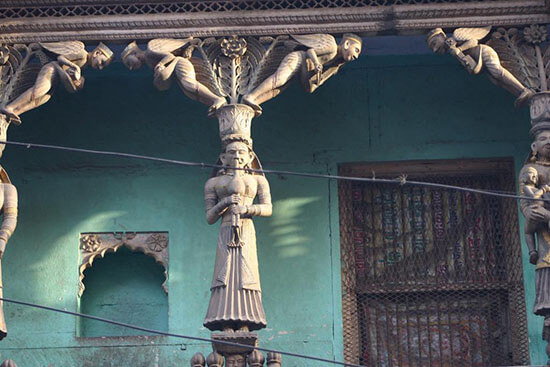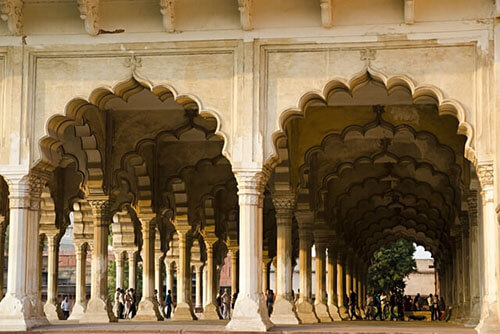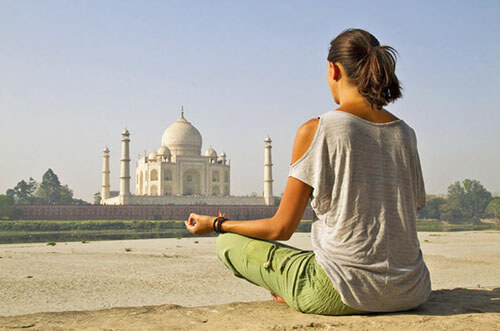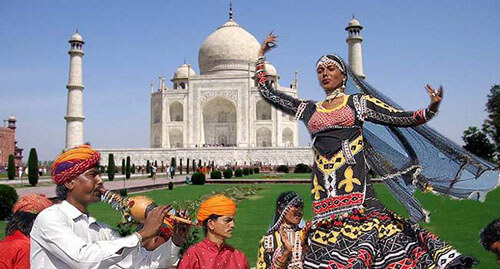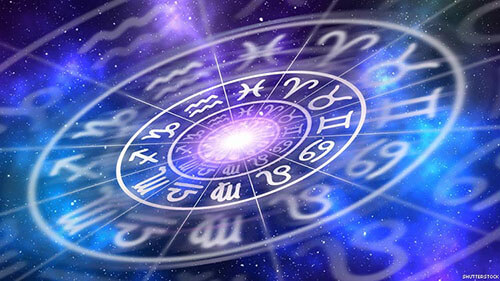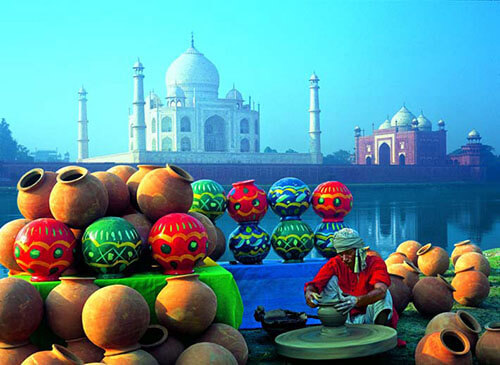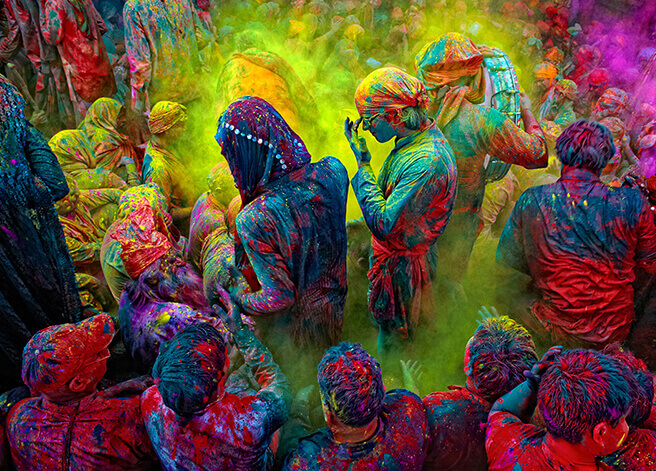Holi is celebrated with enthusiasm and gaiety on the full moon day in the month of Phalgun which is the month of March as per the Gregorian calendar. Entire Barsana town wears a festive look when it is time for Holi celebrations. At Barsana, the 'Latthmaar holi' is famous. The men from Nandgaon who are called 'gops' raid Barsana to mark their victory over the temple of Radhika by hoisting flag over it while the women from Barsana try to attack them with lathis - the long bamboo sticks. The men are well secured & padded because they are not supposed to retaliate to the women and can only try gently to keep them off by sprinkling wet colors on them. In case they get trapped, they are made to dance like a lady as they get dressed as a lady in a sari with facial makeup as well. It is believed that even Lord Krishna was made to dance like this by the men of Barsana.
The same scene is repeated in Nandgaon next day, as men of Barsana raid the village to win over temple of Shriji and women of Nandgao beat them with sticks or lathis to keep them away. Holi songs are sung by the men and women which are mostly based on the exchange of dialouges between Krishna and Radha.
Vrindavan & Mathura - Bankey Bihari & Keshav Dev Ki Holi - 17th March 2019:
Holi is celebrated for over five days in the temples with full fervour. Symbolic Holi celebrations start from the Basant Panchami day with dry red colour becomes integral part of the adornment. The face of Bihariji are decorated with gulal. This appearance of Lord - tastefully designed dresses in bright colours like red, yellow, green, purple, golden, with intricate zari, strings of pearls in zigzag turban on head, crowns of various design with peacock feathers, that big bindi on the forehead, those big shining eyes with familiar notorious twinkle, earrings hanging on cheeks, nose ring precariously balancing on that beautiful sharp nose, that bewitching smile on lips, red colour generously smeared on the cheeks and chin competing with rubies, necklace, garlands, bracelets, armlets, waistband every ornament in its place is simply fascinating, specially charming and inviting. During this period a silver hut is erected for Lard. Thus He is much closer to devotees or easily accessible to communicate and develop relationship. These five days Lord is adorned in spotless white dress which turns into all colours by the end of Darshan period. Goswamis and devotees in groups sing the songs composed by saints and exalted devotees of yesteryears, describing the varying moods and scenes of Holi in temple courtyard as well as in city streets. Such groups also play traditional musical instruments of braj region like Dhap, Khartal, Mridang, Manjeera, Chimta which is delight to watch. Devotees completely overwhelmed by the spirit of Holi throw colored water and coloured powder on each other, visitors and passersby. They sing, dance and cry - HOLI HAI! HOLI HAI!
Holi at Gokul - Chaddimaar Holi
The sounds of songs and drums are heard on the streets here as people from the Ashrams came out to celebrate the festival of 'Holi'. Artists from various parts of the country got together in Gokul to perform the raas leela (dance recitals depicting Krishna's flirtatious interludes with village maidens). Singers, who render folk songs particularly associated with the Holi festival also gathered to take part in the festivities. Holi is celebrated in Gokul by the use of organic colours, usually extracted from flowers such as tesu (Flame of the Forest). Legend says that Lord Krishna played holi with dried tesu flowers, and it is the traditional belief that the Hindu god plays Holi with his devotees in Gokul. Holi celebrates the survival of Prince Prahlada, whose devotion to Lord Vishnu, kept him safe when he was sent to his death by sitting in the midst of a bonfire.
Holi at Dwarikadheesh, Mathura & Banke Bihari Temple, Vrindavan - 19th March 2019:
Dwarikadhish Temple is not only an important temple of Mathura but also of India. Built in 1814, Dwarikadhish Temple is situated in the heart of the city of Mathura. Dwarikadhish Temple that is currently managed by the followers of the Vallabhacharya sect is the most visited temple in Mathura. Located in the eastern part of Mathura, close to holy River Yamuna the temple is an architectural delight to witness.
Seth Gokul Das Parikh, treasurer of the than estate of Gwalior built Dwarkadhish temple which is dedicated to Lord Krishna. He was supposed to be a staunch devotee of Lord Krishna. The temple is an excellent work of art and it's interiors include images of the Lord Krishna, Radha and of other Hindu deities. The architecture of the temple has is based on the elements of local art and aesthetics. The temple carving and paintings are major attractions. The temple is the centre of activity during the festive days of Holi. The temple is also the starting point of the procession which is taken out on streets of Mathura to mark the beginning of the festival.
Holi Festival - 20th March 2019 at Mathura, Vrindavan & around :-
Holi is marked by burning of bonfire on the eve of Holi. The day is also popularly called 'Small Holi'. The main event the festival of colours is celebrated with the colour takes place on the next 'big' day. This is an extremely popular tradition and is celebrated with fervour all across the country and is symbolic of triumph of good over evil. There are numerous legends associated with this ancient tradition and it is difficult to say as to when actually the tradition started. It is stated that during the Vedic period the sacred fire of Holi was burnt amidst the chanting of specific mantras which were intended for the destruction of the demonic forces. It is believed that, this day is celebrated in the memory of Prahlad's victory and the defeat of his aunt 'Holika'. Once upon a time a time, as per legend there existed a mighty demon king Hiranyakashyap who desired that everybody in his kingdom should worship him. His son, Prahlad started worshipping Lord Naarayana. Hiranyakashyap ordered his sister, Holika to sit with Prahlad in the burning fire. Holika was blessed that no fire could harm and burn her as she carried a boon on her. But astonishingly the opposite happened, Holika got charred to death, whereas Prahlad survived because of Narayana's blessings. Thus 'holi' is celebrated to mark the victory of virtue over evil. It is because of this event, Holika (a bonfire) is burnt every year on Holi. The burning of the effigy of Holika is called Holika Dahan.
Holi - The Festival of Colours - 21st March 2019:
The Holi festival is celebrated to commemorates the victory of good over evil & gets its name as the "Festival of Colours" Lord Krishna, also liked to tease, play pranks on the "Gopis" or village girls by drenching them in water and colours to celebrate Holi. Everyone spend the day smearing coloured powder all over each other's faces, throwing coloured water at each other using water guns, enjoying parties, and dancing under water sprinklers. Bhaang (a thick green paste made of cannabis plants) is also traditionally consumed to mark the celebrations. Holi is a very carefree festival that's great fun to participate in getting wet and dirty. One ends up saturated in water, with colour all over the skin and clothes. Some of which doesn't wash out easily. People not only forget their enmity but also throw away their problems, issues and worries. Every nook and corner presents a typically colourful sight. Everywhere men & women - young or old are drenched with different colours and soaked in water which comes from everywhere, there are balloons used as missiles and long water-guns throwing coloured water are a sight to watch. People are seen singing, dancing and throwing colours on each other all over.
Dauji Ki Holi - 22nd March 2019:
Holi will get over for the rest of the nation on 21st March 2018 but it reaches its climax in Dauji on the 22nd March 2018. The Kapra Phaar holi sees women ripping apart the clothes of their men folk - drenching them in color and whipping them with rags dipped in water... OUCH, & lastly the Dauji Huranga puts rainbow to shame as they drench women with buckets of coloured water. The celebration of Holi will mark its culmination on the 22nd March 2019 after celebrating the Gokul & Mahavan ki Holi.
